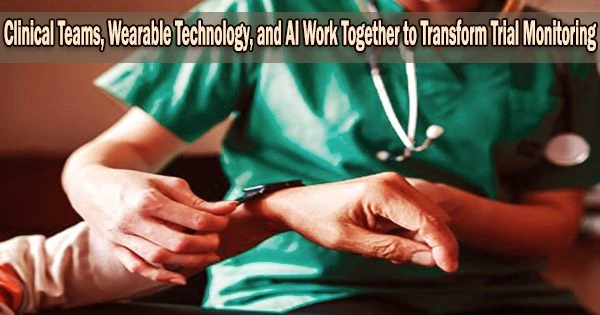Wearable technology, artificial intelligence (AI), and clinical teams are working together to revolutionize the way clinical trials are monitored. Wearable devices, such as smart watches and fitness trackers, can collect data on a person’s vital signs, activity levels, and other health information.
Using motion capture technology and AI, a multidisciplinary team of researchers has created a method to track the development of movement disorders.
A multidisciplinary team of AI and clinical researchers have demonstrated in two groundbreaking studies, both of which were published in Nature Medicine, that by combining wearable technology data on human movement with a potent new medical AI technology, they are able to identify distinct movement patterns, forecast disease progression, and vastly improve the effectiveness of clinical trials in two very different rare disorders, Duchenne muscular dystrophy (DMD) and Friedreich’s ataxia (FA).
Rare hereditary degenerative disorders, DMD and FA impair movement and finally result in paralysis. Both diseases are now incurable, but researchers anticipate that these findings will considerably accelerate the hunt for effective new therapies.
In-depth testing in a clinical setting is usually used to monitor the development of FA and DMD. These articles provide a far more accurate evaluation that also improves the objectivity and correctness of the data gathered.
In comparison to existing approaches, the researchers predict that using these illness indicators will result in a significant reduction in the number of patients needed to develop a new medicine. This is crucial for rare diseases since it can be challenging to find candidates for treatment.
The device may one day be used to monitor or diagnose a number of common disorders that influence movement behavior, including dementia, stroke, and orthopedic issues, in addition to keeping tabs on patients participating in clinical trials.
Senior and corresponding author of both papers, Professor Aldo Faisal, from Imperial College London’s Departments of Bioengineering and Computing, who is also Director of the UKRI Center for Doctoral Training in AI for Healthcare, and the Chair for Digital Health at the University of Bayreuth (Germany), and a UKRI Turing AI Fellowship holder, said:
“Our approach gathers huge amounts of data from a person’s full-body movement more than any neurologist will have the precision or time to observe in a patient. Our AI technology builds a digital twin of the patient and allows us to make unprecedented, precise predictions of how an individual patient’s disease will progress. We believe that the same AI technology working in two very different diseases, shows how promising it is to be applied to many diseases and help us to develop treatments for many more diseases even faster, cheaper and more precisely.”
The two articles emphasize the work of a broad research team that spans the fields of engineering, genetics, clinical specializations, and AI technology. These include researchers at Imperial, the UKRI Center in AI for Healthcare, the MRC London Institute of Medical Sciences (MRC LMS), UCL Great Ormond Street Institute for Child Health (UCL GOS ICH), the NIHR Great Ormond Street Hospital Biomedical Research Center (NIHR GOSH BRC), Ataxia Center at UCL Queen Square Institute of Neurology, Great Ormond Street Hospital, the National Hospital for Neurology and Neurosurgery (UCLH and UCL/UCL BRC), the University of Bayreuth, the Gemelli Hospital in Rome, Italy, and NIHR Imperial College Research Facility.
Our approach gathers huge amounts of data from a person’s full-body movement more than any neurologist will have the precision or time to observe in a patient. Our AI technology builds a digital twin of the patient and allows us to make unprecedented, precise predictions of how an individual patient’s disease will progress. We believe that the same AI technology working in two very different diseases, shows how promising it is to be applied to many diseases and help us to develop treatments for many more diseases even faster, cheaper and more precisely.
Professor Aldo Faisal
Movement fingerprints the trials in detail
Co-author of both studies Professor Richard Festenstein, from the MRC London Institute of Medical Sciences and Department of Brain Sciences at Imperial said, “Patients and families often want to know how their disease is progressing, and motion capture technology combined with AI could help to provide this information. We’re hoping that this research has the potential to transform clinical trials in rare movement disorders, as well as improve diagnosis and monitoring for patients above human performance levels.”
The body worn sensor suit was tested in the DMD-focused study on 21 children at Imperial, Great Ormond Street Hospital, and University College London, as well as 17 healthy age-matched controls. The kids wore the sensors while going about their daily lives, such as eating lunch or playing, as well as doing common clinical assessments (such the 6-minute walk test).
In the FA study, teams at Imperial, the Ataxia Center, UCL Queen Square Institute of Neurology and the MRC London Institute of Medical Sciences worked with patients to identify key movement patterns and predict genetic markers of disease.
The most prevalent hereditary ataxia, FA, is brought on by an unusually large triplet DNA repeat that turns off the FA gene. The team was able to measure the FA gene’s activity without taking any biological samples from patients by using movement data to properly forecast the FA gene’s “switching off.”
The team was able to conduct functional evaluations such walking, hand/arm movements (SCAFI), and a rating scale to assess the level of ataxia disability in 9 FA patients and matched controls. The outcomes of these clinical assessments were validated, and the results were then contrasted with those obtained by applying innovative technologies to the same patients and controls. The latter showing more sensitivity in predicting disease progression.
In both tests, all sensor data was gathered and put into the AI system to build unique avatars and track motions. Researchers were able to identify important movement fingerprints that were distinct in the control group and were present in both people with FA and children with DMD thanks to the large data set and potent computational technique. Many of these AI-based movement patterns had not been described clinically before in either DMD or FA.
Researchers also found that, compared to current gold-standard assessments, the new AI technique could dramatically enhance forecasts of how each patient’s disease will develop over the course of six months. Such a precise prediction helps with more accurate medication dosing and enables faster patient access to innovative medicines through the more effective management of clinical trials.
Smaller numbers for future clinical trials
Clinical teams can forecast illness progression and identify unambiguous disease signs thanks to this novel method of assessing full-body movement measures. These are crucial instruments for evaluating the efficacy of novel medicines during clinical trials.
The new technology may make it easier and more precise for researchers to conduct clinical trials of illnesses that impair movement. Researchers demonstrated in the DMD trial that this new approach might cut the number of children needed to determine if a novel treatment would be effective in half compared to what is needed with present methods.
Similar to this, the researchers in the FA study demonstrated that they could obtain the same precision using 10 patients as opposed to more than 160. When researching uncommon diseases where patient populations are tiny, this AI technique is particularly potent.
Additionally, unlike current clinical studies, which focus on patient cohorts who are either ambulant or non-ambulant, technology now makes it possible to investigate people across life-altering disease occurrences like loss of ambulation.
Co-author on both studies Professor Thomas Voit, Director of the NIHR Great Ormond Street Biomedical Research Center (NIHR GOSH BRC) and Professor of Developmental Neurosciences at UCL GOS ICH, said, “These studies show how innovative technology can significantly improve the way we study diseases day-to-day. The impact of this, alongside specialized clinical knowledge, will not only improve the efficiency of clinical trials but has the potential to translate across a huge variety of conditions that impact movement. It is thanks to collaborations across research institutes, hospitals, clinical specialities and with dedicated patients and families that we can start solving the challenging problems facing rare disease research.”
Joint first author on both studies, Dr. Balasundaram Kadirvelu, post-doctoral researcher at Imperial’s Departments of Computing and Bioengineering, said, “We were surprised to see how our AI algorithm was able to spot some novel ways of analyzing human movements. We call them ‘behavior fingerprints’ because just like your hand’s fingerprints allow us to identify a person, these digital fingerprints characterize the disease precisely, no matter whether the patient is in a wheelchair or walking, in the clinic doing an assessment or having lunch in a café.”
Joint first author on the DMD study and co-author on the FA study, Dr. Valeria Ricotti, honorary clinical lecturer at the UCL GOS ICH said, “Researching rare conditions can be substantially more costly and logistically challenging, which means that patients are missing out on potential new treatments. Increasing the efficiency of clinical trials gives us hope that we can test many more treatments successfully.”
Co-author Professor Paola Giunti, Head of UCL Ataxia Center, Queen Square Institute of Neurology, and Honorary Consultant at the National Hospital for Neurology and Neurosurgery, UCLH, said, “We are thrilled with the results of this project that showed how AI approaches are certainly superior in capturing progression of the disease in a rare disease like Friedreich’s ataxia. With this novel approach we can revolutionize clinical trial design for new drugs and monitor the effects of already existing drugs with an accuracy that was unknown with previous methods.”
“The large number of FA patients who were very well characterized both clinically and genetically at the Ataxia Center UCL Queen Square Institute of Neurology in addition to our crucial input on the clinical protocol has made the project possible. We are also grateful to all our patients who participated in this project.”
















